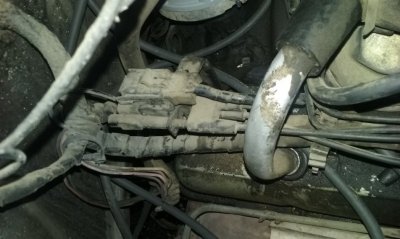CODE 23 - M/C SOLENOID VOLTAGE LOW TO ECM
Circuit Description :
Code 23 says the ECM has seen the voltage at ECM 18" stay low instead of rising and falling as the M/C solenoid is turned "ON" and "OFF". This could be caused by an open in the M/C solenoid circuit or a ground on the ECM side of the M/C solenoid.
An open would cause a full rich condition and cause poor economy, odor, smoky exhaust or poor driveability. A ground would cause a full lean condition and cause poor driveability.
Test Description :
Checks for a complete circuit from the battery to the M/C solenoid dwell lead. It should be battery voltage. Battery voltage means there might be an open circuit between the dwell connector and ground. No voltage could be either an open between the connector and battery or a ground on the ECM side of the M/C solenoid.
Checks for B+ on the pink ignition source wire. Test light should light between the ignition source and ground.
2A. Checks for an open in the solenoid to ECM circuit. A normal circuit would read about battery voltage at the ECM Terminal "18".
This step determines whether the fault is in the M/C solenoid, a ground in the circuit to the ECM, or the ECM. A light would indicate a ground in circuit to Terminal "18" or a faulty ECM. A voltmeter can't be used because it is normal to have enough current flow through the ECM even with the circuit open to make a voltmeter read, but not enough to light a test light.
This checks for ground in the wire to ECM Term. "18". If it is grounded, the light will stay "ON".
CODE 34 - DIFFERENTIAL PRESSURE (VAC) SENSOR
Circuit Description :
Code 34 says that the ECM has seen the following:
Pressure outside a specified voltage range (seen by ECM as voltage at Term. 20).
Engine RPM less than a given value (normally curb idle).
Engine at operating temperature.
All the above for a time greater than specified.
The VAC sensor is a differential pressure sensor that measures the difference in pressure between atmosphere and manifold. The VAC sensor supplies high voltage at high vacuum. High voltage increases spark advance while low voltage reduces advance.
Test Description :
Checks output of sensor at idle to determine if sensor is within specification. Normal sensor will read less than 1 volt with key "ON", engine "OFF" and over 3 volts with engine idling with a minimum of 15" vacuum.
A normal sensor should drop below 1 volt when vacuum is removed. This step tests for that drop at the sensor.
Check for a ground in wire from Term. "B" of VAC sensor to ECM. This would be the case if the voltage went up over 2 volts when the line was opened.
Checks to see if the fault is in the sensor, or in the ECM wiring, or in the ECM. If the voltage goes over 2 volts with the sensor disconnected, the sensor or sensor connections are faulty.
CODE 54 - M/C SOLENOID VOLTAGE HIGH TO ECM
Circuit Description :
Code 54 will be set if there is constant high voltage at ECM Term. "18".
A shorted solenoid or a wiring short to 12V on circuit to ECM would cause the solenoid to remain in the full rich position, resulting in potential ECM damage, excessive fuel consumption, and excessive exhaust odor.
*** THIS PROCEDURE HAS BEEN UPDATED BY TSB #86-B-102, DATED 7/86
Some 1985-86 vehicles may experience a shorted out electric purge solenoid valveto the canister purge system. This condition may be caused by moisture enteringthe electrical portion of the canister purge solenoid valve and setting a false Code 54. If this condition is encountered and the inspection of the solenoid indicates that the replacement of the solenoid is required, replace the purge solenoid valve and install a new moisture shield P/N 14066503, which has been released to correct this condition.
The ECM may also have a failed quad driver which controls the M/C solenoid and the ECM should be checked to make sure it was not damaged if the purge solenoid was shorted.
Before the new moisture shield can be installed modifications to the purge solenoid valve bracket and moisture shield must be made.
MODIFICATION: SOLENOID VALVE
The solenoid valve bracket must be reshaped to allow the valve to fit inside the moisture shield. Hold the solenoid valve and bracket firmly and bend the bracket into an "L" shape.
MODIFICATION: MOISTURE SHIELD
The moisture shield must be modified to allow the installation of a tie strap to hold the shield to the solenoid valve. A "V" shaped slot must be cut in both sides of the shields opposite the holed tab side of shield. After the modification to the shield and solenoid bracket have been completed, install the shield on the solenoid. Install the tie stap, P/N 15501907 tightly around the solenoid shield and cut off the excess length. Make sure that the tie strap is positionedbetween the center hose port and the electrical connection to the solenoid valve.
Test Description :
Checks the M/C solenoid resistance to determine if the fault is in the solenoid or ECM harness/ECM. A normal solenoid has about 20 to 32 ohms of resistance.
Checks to see if reason for high voltage to Term. '18" is a faulty ECM or a short to 12V on that wire. If the test light illuminates with both ends of harness disconnected, there is a short to 12V in the wire.
I have the associated diagnostic charts and wiring diagrams for the above if you need them let me know.


